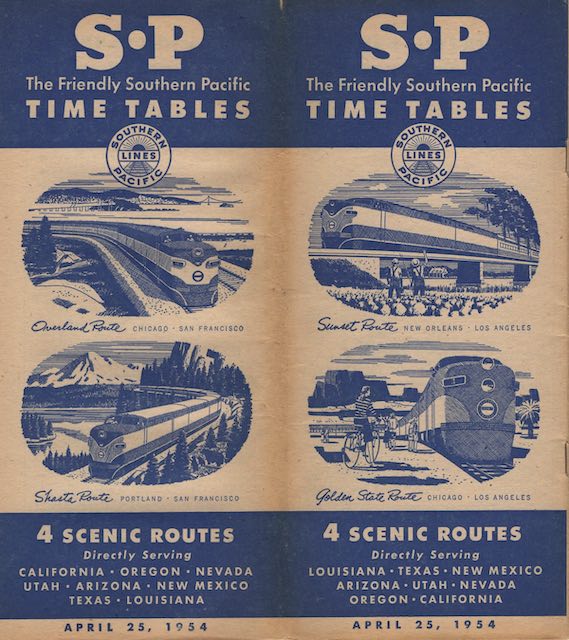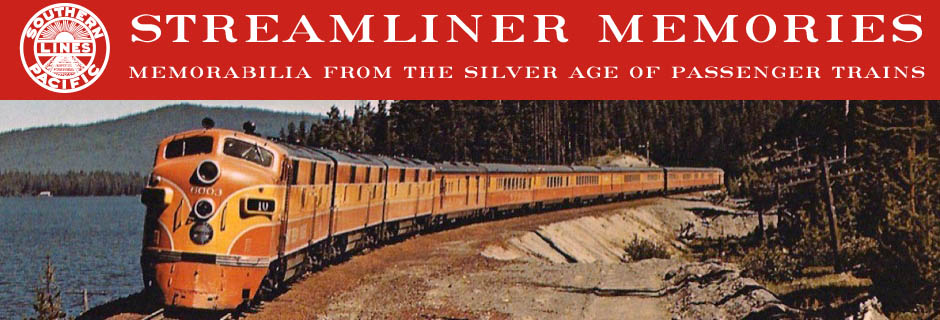Today’s 48-page timetable (which puts the cover shown below on the back) has a front-page ad proclaiming “faster streamliner schedules Chicago-California.” The Golden State, it says, was an hour and 50 minutes faster eastbound and an hour faster westbound. The San Francisco Overland was an hour faster in both directions.
 Click image to download a 33.6-MB PDF of this timetable from the Ellery Goode collection.
Click image to download a 33.6-MB PDF of this timetable from the Ellery Goode collection.
As I read the timetable, the Golden State took 41-1/4 hours to get from Chicago to Los Angeles. That was only 1-1/2 hours slower than the Super Chief or City of Los Angeles. Despite the speed-up, the eastbound time was still nearly 42-1/2 hours, or 2-3/4 hours slower than the competition.
It’s too bad SP couldn’t squeeze another couple of hours out of their timetables, which would have made it a three-way race between Chicago and Los Angeles. SP could have reduced the number of intermediate stops: the Golden State made 27 while the Super Chief made only 16. It could also have reduced the length of some of the stops: the Golden State spent 15 minutes for crew changes in Kansas City, El Paso, and Tucumcari plus 10 or more minutes in several more cities. The Super Chief, in contrast, spent only 10 in Kansas City, Albuquerque, and Barstow.
Finally, SP could have reduced the amount of pad in its schedule. The Golden State took 2 hours 49 minutes to get from Palm Springs to Los Angeles but only 2 hours 18 minutes from LA to Palm Springs. The extra 21 minutes is pad, which allows the railroad to claim it arrived in LA on time even if the train was running 21 minutes late. In contrast, the Super Chief had only 3 minutes of pad in its schedule from San Bernardino to Los Angeles.
Making these three changes could have cut more than an hour out of the schedule. More time could have been saved by running trains a little faster without violating the federal 79-mph speed limit. From Tucson to Bisbee Junction, 102 miles, the average speed was just 49 mph. From Bisbee Junction to El Paso, 187 miles, the speed was under 53 mph. In each case, the railroad was shorter and straighter than highways, so I suspect speeds could have been increased 10 to 15 mph.
Meanwhile, the San Francisco Overland wasn’t a participant in the speed races, having conceded the top spot to the City of San Francisco. With this timetable, the Overland‘s time was reduced to 48-1/3 hours westbound and 47-1/2 hours eastbound, while the City of San Francisco was 40 hours each way (39-1/2 to Oakland). A third train, the Gold Coast, required 58 hours westbound and 58-1/2 hours eastbound; it would disappear from the timetable by the end of 1954.

Somewhat agree about the padding, but in the case of SP’s westbound trains, they had to climb from below sea level in the Imperial Valley, up and over Beaumont Pass, a distance of over 100 miles of uphill running, so the lengthier time westbound makes some sense.
Santa Fe’s trains that ran over the 2nd district didn’t need as much slack in their schedules, owing to 2.2% downhill grade from Pasadena to L.A. Once the trains rounded the corner near Glenarm St. and Fair Oaks Avenue, they could mostly coast down the grade to LAUPT.
Incidentally, the San Francisco Chief had a much longer route (2555 miles) than the Overland Route, and initially required 47-1/2 hours to make the trip. The SFO Chief’s purpose was not so much as a Chicago-SFO train, as it was to serve intermediate and underserved markets, with through cars from Houston, New Orleans, and Kansas City to the Bay Area, and a daytime schedule between Oakland and Bakersfield.